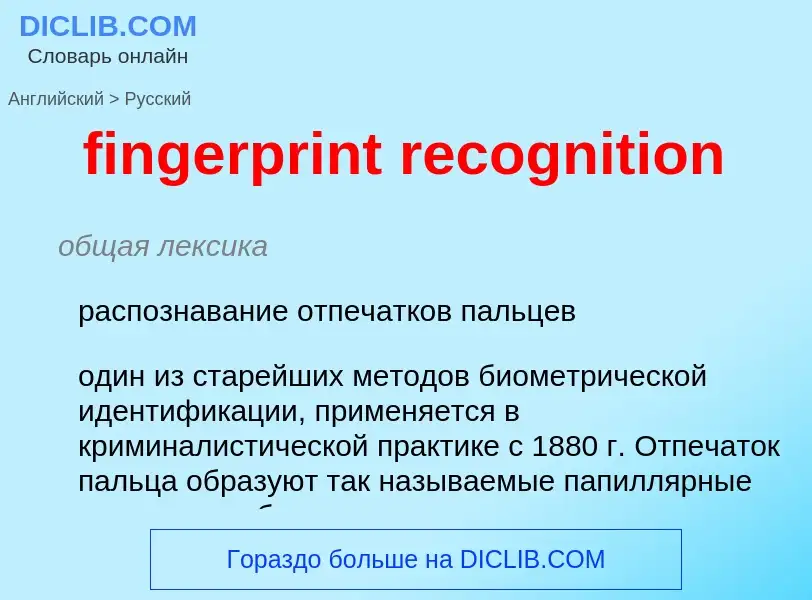Перевод и анализ слов искусственным интеллектом ChatGPT
На этой странице Вы можете получить подробный анализ слова или словосочетания, произведенный с помощью лучшей на сегодняшний день технологии искусственного интеллекта:
- как употребляется слово
- частота употребления
- используется оно чаще в устной или письменной речи
- варианты перевода слова
- примеры употребления (несколько фраз с переводом)
- этимология
fingerprint recognition - перевод на русский
общая лексика
распознавание отпечатков пальцев
один из старейших методов биометрической идентификации, применяется в криминалистической практике с 1880 г. Отпечаток пальца образуют так называемые папиллярные линии на гребешковых выступах кожи, разделенных бороздками. Из этих линий складываются сложные узоры (дуговые, петлевые и завитковые), которые обладают свойствами а) индивидуальности и неповторимости, б) устойчивости (от внутриутробного развития и до разложения трупа) и в) восстанавливаемости (при поверхностном нарушении кожи рисунок линий восстанавливается в прежнем виде)
Смотрите также
общая лексика
считыватель отпечатков пальцев
устройство ввода отпечатков пальцев в компьютерную систему для распознавания
Смотрите также
[m(a)i'nju:ʃii:]
общая лексика
шаблон отпечатка пальца, детальный протокол ввода отпечатка пальца
атрибут пользователя в базе данных для биометрического контроля
Смотрите также
существительное
Латинский язык
мелочи
детали
существительное
синоним
глагол
общая лексика
снимать отпечатки пальцев
Определение
Википедия

A fingerprint is an impression left by the friction ridges of a human finger. The recovery of partial fingerprints from a crime scene is an important method of forensic science. Moisture and grease on a finger result in fingerprints on surfaces such as glass or metal. Deliberate impressions of entire fingerprints can be obtained by ink or other substances transferred from the peaks of friction ridges on the skin to a smooth surface such as paper. Fingerprint records normally contain impressions from the pad on the last joint of fingers and thumbs, though fingerprint cards also typically record portions of lower joint areas of the fingers.
Human fingerprints are detailed, nearly unique, difficult to alter, and durable over the life of an individual, making them suitable as long-term markers of human identity. They may be employed by police or other authorities to identify individuals who wish to conceal their identity, or to identify people who are incapacitated or deceased and thus unable to identify themselves, as in the aftermath of a natural disaster.
Their use as evidence has been challenged by academics, judges and the media. There are no uniform standards for point-counting methods, and academics have argued that the error rate in matching fingerprints has not been adequately studied and that fingerprint evidence has no secure statistical foundation. Research has been conducted into whether experts can objectively focus on feature information in fingerprints without being misled by extraneous information, such as context.



![Criminal [[Alvin Karpis]] had his fingerprints surgically removed in 1933 Criminal [[Alvin Karpis]] had his fingerprints surgically removed in 1933](https://commons.wikimedia.org/wiki/Special:FilePath/Altered Fingerprints of Alvin Karpis.jpg?width=200)

.jpg?width=200)




![ThinkPad]] T440p, released in 2013 ThinkPad]] T440p, released in 2013](https://commons.wikimedia.org/wiki/Special:FilePath/Fingerprint sensor ThinkPad T440p.jpg?width=200)

![Female clerical employees of the [[Los Angeles Police Department]] being fingerprinted and photographed in 1928 Female clerical employees of the [[Los Angeles Police Department]] being fingerprinted and photographed in 1928](https://commons.wikimedia.org/wiki/Special:FilePath/Fingerprinting 1928.jpg?width=200)


![William Herschel]] 1859/60 William Herschel]] 1859/60](https://commons.wikimedia.org/wiki/Special:FilePath/Fingerprints taken by William James Herschel 1859-1860.jpg?width=200)




